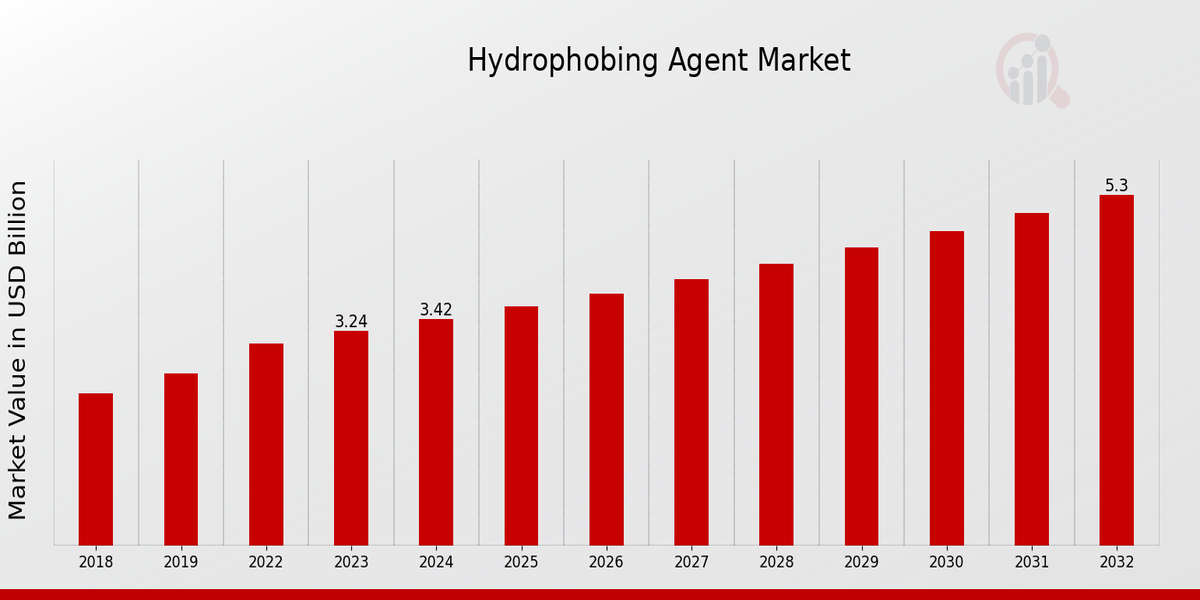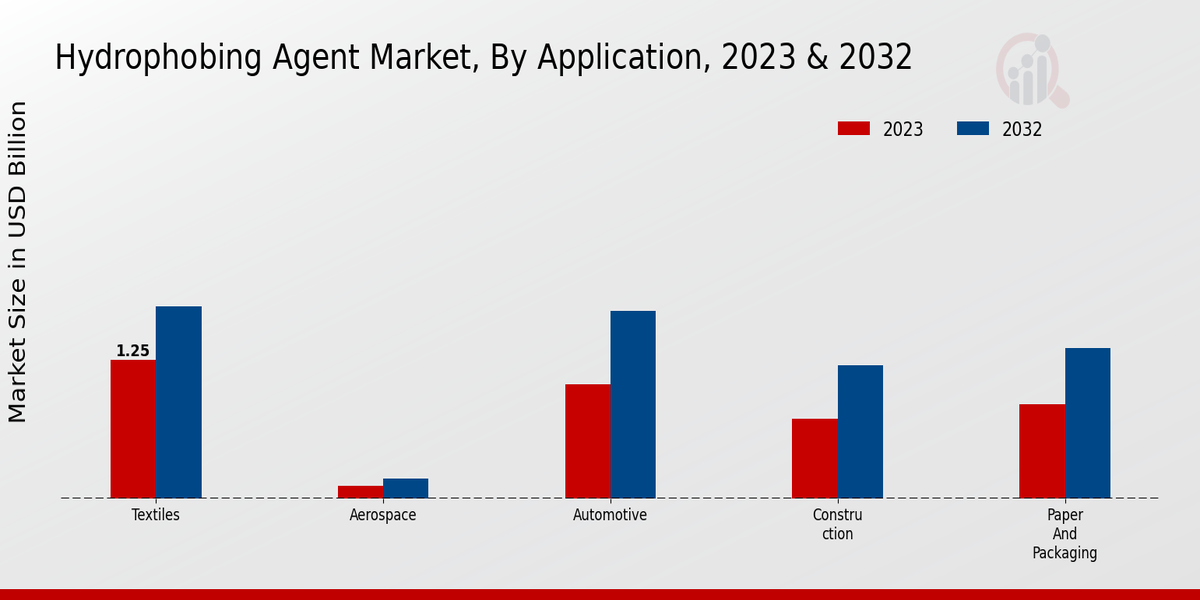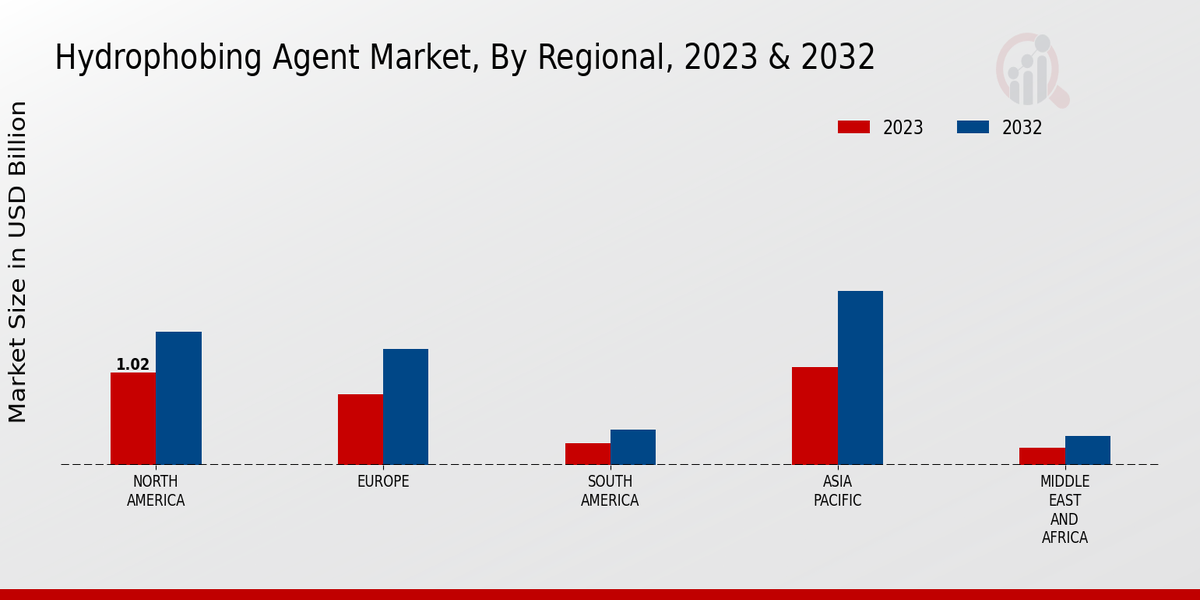Global Hydrophobing Agent Market Overview
The Hydrophobing Agent Market Size was estimated at 3.06 (USD Billion) in 2022. The Hydrophobing Agent Industry is expected to grow from 3.24 (USD Billion) in 2023 to 5.3 (USD Billion) by 2032. The Hydrophobing Agent Market CAGR (growth rate) is expected to be around 5.63% during the forecast period (2024 - 2032).
Key Hydrophobing Agent Market Trends Highlighted
The hydrophobing agent market is characterized by the increasing demand for water-repellent materials across various industries. Key market drivers include the growing construction sector, particularly in emerging markets, where the use of hydrophobic coatings for buildings and infrastructure is becoming more prevalent. Additionally, the rising popularity of outdoor activities and the increasing adoption of moisture-wicking fabrics in the apparel industry are contributing to market growth.Opportunities for exploration and capture in the hydrophobing agent market lie in the development of environmentally sustainable and eco-friendly solutions. As consumers become more conscious of their environmental impact, manufacturers are responding with innovative hydrophobic agents that minimize their carbon footprint. Furthermore, the expansion into new application areas, such as medical devices, electronics, and food packaging, presents significant potential for market expansion.Recent trends in the hydrophobing agent market include the emergence of nanotechnology-based solutions. These advanced agents offer superior water-repellency and durability, making them suitable for demanding applications in the aerospace and automotive industries. Additionally, the growing focus on anti-icing and anti-fouling properties is driving the development of specialized hydrophobic agents for marine and industrial settings.

Source: Primary Research, Secondary Research, MRFR Database and Analyst Review
Hydrophobing Agent Market Drivers
Growing Demand for Hydrophobic Materials in Various Industries
The increasing use of hydrophobic materials in a wide range of industries, including construction, automotive, and textiles, is a major driver of the Hydrophobing Agent Market Industry. Hydrophobic materials are materials that repel water and moisture, making them ideal for use in applications where water resistance is crucial. The construction industry is a major consumer of hydrophobic materials, as they are used in roofing, siding, and insulation to protect buildings from water damage.The automotive industry also uses hydrophobic materials in car seats, carpets, and other components to make them more resistant to spills and stains. In the textile industry, hydrophobic materials are used to create water-resistant fabrics for clothing, sportswear, and other applications. The growing demand for hydrophobic materials in these and other industries is expected to continue to drive the growth of the Hydrophobing Agent Market Industry in the coming years.
Rising Environmental Concerns and Regulations
Increasing environmental concerns and regulations regarding the use of harmful chemicals are also driving the growth of the Hydrophobing Agent Market Industry. Traditional hydrophobing agents often contain harmful chemicals that can pollute the environment and pose health risks. As a result, there is a growing demand for eco-friendly and sustainable hydrophobing agents. Many manufacturers are now developing and marketing hydrophobing agents that are made from renewable resources and that have a low environmental impact.These eco-friendly hydrophobing agents are expected to gain market share in the coming years as consumers and businesses become more aware of the environmental benefits of using sustainable products.
Advancements in Nanotechnology
Advancements in nanotechnology are also having a positive impact on the growth of the Hydrophobing Agent Market Industry. Nanotechnology is the science of manipulating matter at the atomic and molecular scale. This technology is being used to develop new and improved hydrophobing agents with enhanced properties. For example, researchers are developing nano-sized hydrophobing agents that can be used to create ultra-hydrophobic surfaces. These surfaces are highly resistant to water and other liquids, and they have a wide range of potential applications, such as in the development of self-cleaning materials and anti-fouling coatings.
Hydrophobing Agent Market Segment Insights
Hydrophobing Agent Market Application Insights
The Hydrophobing Agent Market is segmented into several applications, including textiles, paper and packaging, construction, automotive, and aerospace. The textiles segment is expected to account for the largest share of the market in 2023, with a value of 1.25 billion USD. This is due to the increasing demand for water-resistant and stain-resistant fabrics in various end-use industries such as apparel, home textiles, and industrial fabrics. The paper and packaging segment is also expected to experience significant growth, with a projected market value of 0.85 billion USD in 2023.The growing demand for moisture-resistant packaging solutions in the food, beverage, and pharmaceutical industries is driving the growth of this segment. The construction segment is another major application area for hydrophobing agents, with an estimated market value of 0.72 billion USD in 2023. Hydrophobing agents are used in construction materials to enhance water repellency and durability, making them ideal for applications such as waterproofing membranes, roofing materials, and concrete sealants. The automotive and aerospace segments are also expected to contribute to the growth of the Hydrophobing Agent Market, with increasing demand for lightweight and water-resistant materials in these industries.Overall, the Hydrophobing Agent Market is expected to witness steady growth in the coming years, driven by increasing demand for water-resistant and durable materials across various end-use industries. The growing awareness of sustainability and environmental concerns is also expected to fuel the adoption of eco-friendly hydrophobing agents, further propelling market growth.

Source: Primary Research, Secondary Research, MRFR Database and Analyst Review
Hydrophobing Agent Market Chemistry Insights
The hydrophobing agent market is segmented by Chemistry into Organic Hydrophobing Agents, Inorganic Hydrophobing Agents, Silane-based Hydrophobing Agents, and Fluorine-based Hydrophobing Agents. Among these, Organic Hydrophobing Agents held the largest market share in 2023, accounting for nearly half of the market revenue. This is due to their versatility and effectiveness in a wide range of applications. Inorganic Hydrophobing Agents are expected to witness the highest growth rate during the forecast period, owing to their increasing adoption in the construction and automotive industries.Silane-based Hydrophobing Agents are gaining traction due to their ability to enhance the water-repellency and durability of surfaces. Fluorine-based Hydrophobing Agents are expected to witness steady growth, driven by their superior performance in extreme conditions.
Hydrophobing Agent Market Form Insights
The Hydrophobing Agent Market revenue from the Form segment is expected to reach USD 1.45 billion by 2027, exhibiting a CAGR of 5.3% during the forecast period. The market growth is attributed to the increasing demand for liquid hydrophobing agents due to their ease of application and high effectiveness in improving the water repellency of various materials. Liquid hydrophobing agents hold a dominant share in the market, accounting for over 55% of the revenue in 2023. The segment is expected to maintain its dominance throughout the forecast period, driven by the growing adoption of liquid agents in the construction, automotive, and textile industries.Powder and granular hydrophobing agents are also gaining traction due to their cost-effectiveness and suitability for specific applications.
Hydrophobing Agent Market End-Use Industry Insights
The Hydrophobing Agent Market is segmented into various end-use industries, including automotive, construction, textile, paper and packaging, aerospace and defense, and consumer electronics. Each segment exhibits unique characteristics and growth dynamics. The automotive industry is a significant consumer of hydrophobing agents, utilizing them in coatings, sealants, and lubricants to enhance vehicle performance and durability. The growing demand for lightweight and fuel-efficient vehicles drives the adoption of hydrophobing agents in this sector.In the construction industry, hydrophobing agents are employed in waterproofing membranes, coatings, and sealants to protect structures from moisture damage. The increasing construction activities, particularly in emerging economies, contribute to the demand for hydrophobing agents in this segment. The textile industry uses hydrophobing agents to impart water-repellent properties to fabrics, enhancing their durability and performance. The growing demand for functional and protective textiles in various applications fuels the growth of this segment.The paper and packaging industry utilizes hydrophobing agents to create moisture-resistant packaging materials, protecting products from moisture and contamination. The rising demand for sustainable packaging solutions and the increasing consumption of packaged goods drives the demand for hydrophobing agents in this segment. The aerospace and defense industry employs hydrophobing agents in coatings and sealants to protect aircraft components from corrosion and moisture damage. The growing investments in defense and aerospace programs contribute to the demand for hydrophobing agents in this segment.The consumer electronics industry uses hydrophobing agents in coatings and encapsulations to protect electronic devices from moisture and environmental factors. The increasing popularity of waterproof and durable electronic devices drives the growth of this segment.
Hydrophobing Agent Market Regional Insights
The Hydrophobing Agent Market segmentation examines regional markets, including North America, Europe, APAC, South America, and MEA. In 2023, North America dominated the market with a revenue of 1.02 Billion USD, followed by Europe with 0.78 Billion USD. APAC, with its rapidly growing economies, is projected to exhibit the highest growth rate of 6.2% CAGR from 2023 to 2032, reaching a value of 1.93 Billion USD by 2032. South America and MEA are expected to contribute significantly to the market's growth, with a combined revenue of 0.62 Billion USD in 2032.This market segmentation provides valuable insights for businesses looking to expand their reach and target specific regional markets.

Source: Primary Research, Secondary Research, MRFR Database and Analyst Review
Hydrophobing Agent Market Key Players And Competitive Insights
Major players in the Hydrophobing Agent Market industry are constantly engaged in strategic initiatives to maintain their competitive edge. Leading Hydrophobing Agent Market players are investing in research and development to introduce innovative products and technologies. The Hydrophobing Agent Market is characterized by intense competition, with established players vying for market share. These players are engaged in mergers and acquisitions to expand their product portfolios and geographical reach. The competitive landscape is expected to remain dynamic in the coming years, with new entrants and innovative solutions shaping the market.BASF is a leading player in the Hydrophobing Agent Market, offering a comprehensive range of products and solutions for various industries. The company's strong focus on innovation and customer-centric approach has enabled it to maintain its position as a market leader. BASF's commitment to sustainability and environmental responsibility aligns with the growing demand for eco-friendly solutions. The company's presence and extensive distribution network provide it with a competitive advantage in reaching customers worldwide.Clariant is a prominent competitor in the Hydrophobing Agent Market, known for its innovative products and technical expertise. The company offers a wide range of solutions tailored to meet the specific requirements of diverse industries. Clariant's emphasis on research and development has resulted in the introduction of cutting-edge technologies and formulations. The company's strong partnerships with customers and commitment to delivering high-quality products have contributed to its success in the market. Clariant's footprint and established distribution channels enable it to effectively serve customers worldwide.
Key Companies in the Hydrophobing Agent Market Include
- Siltech Corporation
- Lonza Group Ltd
- Croda International Plc
- AkzoNobel
- Clariant AG
- Wacker Chemie AG
- Dow Chemical Company
- Huntsman Corporation
- BASF SE
- Ashland Inc.
- Momentive Performance Materials Inc.
- Solvay
- Evonik Industries
- 3M Company
Hydrophobing Agent Market Industry Developments
The hydrophobing agent market is projected to reach USD 5.3 billion by 2032, exhibiting a CAGR of 5.63% during the forecast period (2024-2032). Growing demand for hydrophobing agents in various end-use industries, including construction, textiles, and personal care, is driving the market growth. The increasing adoption of water-resistant and moisture-proof materials in the construction industry to enhance the durability and lifespan of buildings is a major factor contributing to the market's growth. Moreover, rising consumer preference for water-repellent and stain-resistant fabrics is fueling demand for hydrophobing agents in the textile industry. The growing awareness of personal hygiene and the increasing use of hydrophobic agents in cosmetics and skin care products are further propelling the market forward.
Hydrophobing Agent Market Segmentation Insights
Hydrophobing Agent Market Application Outlook
- Textiles
- Paper and Packaging
- Construction
- Automotive
- Aerospace
Hydrophobing Agent Market Chemistry Outlook
- Organic Hydrophobing Agents
- Inorganic Hydrophobing Agents
- Silane-based Hydrophobing Agents
- Fluorine-based Hydrophobing Agents
Hydrophobing Agent Market Form Outlook
- Liquid
- Powder
- Granular
- Emulsion
Hydrophobing Agent Market End-Use Industry Outlook
- Automotive
- Construction
- Textile
- Paper and packaging
- Aerospace and defense
- Consumer electronics
Hydrophobing Agent Market Regional Outlook
- North America
- Europe
- South America
- Asia Pacific
- Middle East and Africa
| Report Attribute/Metric |
Details |
| Market Size 2022 |
3.06 (USD Billion) |
| Market Size 2023 |
3.24 (USD Billion) |
| Market Size 2032 |
5.3 (USD Billion) |
| Compound Annual Growth Rate (CAGR) |
5.63% (2024 - 2032) |
| Report Coverage |
Revenue Forecast, Competitive Landscape, Growth Factors, and Trends |
| Base Year |
2023 |
| Market Forecast Period |
2024 - 2032 |
| Historical Data |
2019 - 2023 |
| Market Forecast Units |
USD Billion |
| Key Companies Profiled |
Siltech Corporation, Lonza Group Ltd, Croda International Plc, AkzoNobel, Clariant AG, Wacker Chemie AG, Dow Chemical Company, Huntsman Corporation, BASF SE, Ashland Inc., Momentive Performance Materials Inc., Solvay, Evonik Industries, 3M Company |
| Segments Covered |
Application, Chemistry, Form, End-Use Industry, Regional |
| Key Market Opportunities |
Increased demand for waterproofing coatings Growing construction industry Technological advancements in hydrophobing agents Rising consumer awareness of sustainability Expanding applications in diverse industries |
| Key Market Dynamics |
Rising demand from the construction industry Growing use of personal care products Increasing adoption in the food and beverage industry |
| Countries Covered |
North America, Europe, APAC, South America, MEA |
Frequently Asked Questions (FAQ) :
The hydrophobing agent market size was valued at USD 3.24 billion in 2023.
The hydrophobing agent market is expected to reach USD 5.30 billion by 2032, exhibiting a CAGR of 5.63% during the forecast period (2023-2032).
Asia Pacific is expected to dominate the hydrophobing agent market throughout the forecast period, owing to the increasing demand for hydrophobing agents in the automotive and construction industries in the region.
Hydrophobing agents are primarily used in the manufacturing of water-resistant and water-repellent coatings, textiles, paper, and leather products.
Key competitors in the hydrophobing agent market include 3M, Solvay, Evonik, Dow, and DuPont.
The growth of the hydrophobing agent market is primarily driven by the increasing demand for water-resistant and water-repellent products across various industries, such as automotive, construction, and textiles.
The hydrophobing agent market faces challenges related to environmental regulations and the availability of cost-effective and sustainable alternatives.
Emerging trends in the hydrophobing agent market include the development of eco-friendly and bio-based hydrophobing agents, as well as the integration of nanotechnology for enhanced performance.
Potential growth opportunities for the hydrophobing agent market lie in the expansion of emerging markets, the increasing demand for high-performance materials, and the development of innovative applications.
Key strategies adopted by players in the hydrophobing agent market include product innovation, capacity expansion, strategic partnerships, and mergers and acquisitions.





























